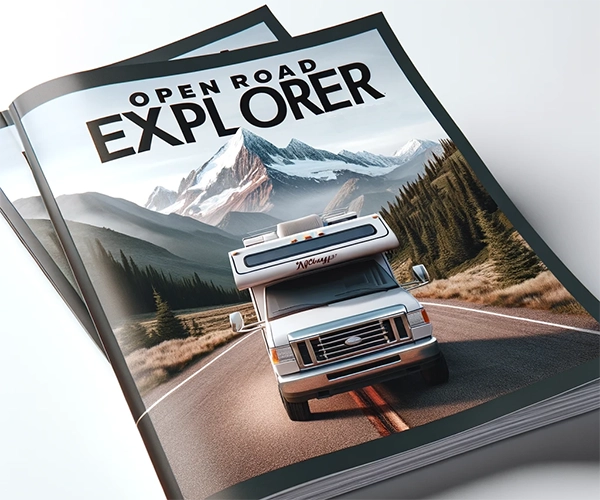Table of Contents

Embracing the Sun: Sustainable Voyages for the Boondocking RVer
Imagine the freedom of traveling where you want, when you want, all while leaving a minimal footprint on the environment. That’s the heart of boondocking with solar power—a sustainable voyage that combines the independence of RV living with the boundless energy of the sun.
Key Takeaways: Article-at-a-Glance
- Understanding solar power basics is essential for a successful boondocking experience.
- Calculating your energy needs ensures you select the right solar setup for your RV.
- Diverse solar panel options offer flexibility and efficiency for off-grid living.
- Maximizing your roof’s real estate for solar panels can significantly boost energy capture.
- Choosing the right solar setup means more freedom and less environmental impact on your travels.
Solar Energy Basics: Harnessing the Sun’s Power
Solar energy is a game-changer for RVers. It’s clean, renewable, and after the initial setup cost, it’s practically free. Solar panels capture sunlight and convert it into electricity, which can be used to power your RV’s appliances, lights, and gadgets. This means you can stay off-grid longer without the need for noisy generators or costly campground hookups.
Calculating Your Energy Needs: A Boondocker’s Guide
Before diving into solar, it’s crucial to know how much power you’ll need. Start by listing all the electrical devices you use and tally up their wattage. Remember to consider how often you use each item daily. This will give you a daily watt-hour number, which is key to sizing your solar power system correctly.
Choosing the Right Solar Setup for Your RV
- Match your solar panel wattage to your daily energy consumption.
- Opt for a solar charge controller that can handle your system’s voltage and current.
- Consider the size of your battery bank—more storage means more off-grid time.
- Factor in the type of RV you have; some setups are better suited for certain models.
- Think about portability; do you want to park in the shade and still have your panels in the sun?
- Don’t forget about durability; your panels should withstand the rigors of the road.
- Research warranties and customer support for peace of mind.
The Power to Roam: Selecting Solar Panels for Off-Grid RV Living
Choosing the right solar panels is like picking the best travel companion—they need to be reliable, efficient, and ready for adventure. Solar panels come in various types, each with its own advantages, from the robustness of monocrystalline to the affordability of polycrystalline. Thin-film panels are lightweight and flexible, ideal for RVs with weight restrictions or curved surfaces.
Panel Types and Efficiency: What You Need to Know
Monocrystalline panels are highly efficient and perform better in low-light conditions, making them a top choice for many RVers. Polycrystalline panels, while slightly less efficient, offer a more budget-friendly option. Thin-film panels can be a good fit for those with unique RV roofs but typically require more space due to their lower efficiency.
Real Estate on Your Roof: Maximizing Space and Sun Exposure
Your RV’s roof is prime real estate for solar panels, but it’s limited. To make the most of it, position your panels where they can get maximum sun exposure. This often means avoiding shaded areas or places that might be covered by satellite dishes or air conditioning units. A well-planned layout ensures that you capture as much sunlight as possible, translating to more power for your off-grid adventures.
Portable vs. Fixed Panels: Weighing the Pros and Cons
- Portability: Portable panels can be moved to catch the sun, even if your RV is parked in the shade.
- Convenience: No installation required; set them up as needed.
- Security: Easy to pack up and secure when not in use or while you’re away from your RV.
- Flexibility: Adjust the angle throughout the day for maximum sun exposure.
- Cost: Often more affordable upfront than a fixed system.
- Efficiency: Fixed panels are positioned to optimize sun exposure, potentially generating more power.
- Durability: Fixed panels are designed to withstand the rigors of travel and harsh weather conditions.
- Maintenance: Less frequent need to clean and adjust fixed panels compared to portable ones.

Storing Sunshine: Battery Banks for Evening Energy
Once you’ve harnessed the sun’s power, you need somewhere to store it. That’s where your battery bank comes in. It’s like a savings account for electricity, holding onto that energy until you’re ready to use it—day or night. The key is to have enough battery capacity to meet your needs, even when the sun isn’t shining.
Understanding Battery Types: AGM, Lithium, and Beyond
AGM batteries are durable and spill-proof, a solid choice for most RV setups. Lithium batteries, though more expensive, pack a lot of power into a lighter, more compact package and last longer than AGM batteries. There are other types too, like gel and flooded lead-acid, but these are less common in modern RV solar setups due to their maintenance needs and lower efficiency.
Power Preservation: Optimizing Your Battery Setup
To get the most out of your batteries, you need to keep them healthy. This means not draining them too low—aim to use only 50% of the battery’s capacity before recharging. Also, make sure your solar charge controller is set up to prevent overcharging, which can reduce your batteries’ lifespan.
Battery Maintenance: Keeping the Energy Flowing
Regular maintenance is crucial. For most battery types, this means checking the connections for corrosion, ensuring they’re tight and clean. For certain batteries, like flooded lead-acid, you’ll also need to check fluid levels. Always follow the manufacturer’s guidelines to keep your batteries in top shape.
A Guiding Light: Effective Solar Panel Installation
Installing solar panels is a big step towards energy independence. It’s a task that can be tackled by DIY enthusiasts with the right tools and a bit of know-how. However, it’s important to do it correctly to avoid damage to your RV or your new solar panels.
Step-by-Step Installation Guide for Solar Panels
- Plan Your Layout: Before drilling any holes, plan where each panel will go. Use your RV’s roof diagram to avoid obstructions and maximize sun exposure.
- Gather Tools and Materials: You’ll need a drill, sealant, screws, and the mounting hardware that comes with your panels.
- Mounting the Hardware: Follow the instructions for your specific mounting hardware. Ensure it’s securely attached to your RV’s roof.
- Securing the Panels: Once the mounts are in place, attach your panels. Make sure they’re tight enough to withstand high winds.
- Wiring: Connect the panels to your charge controller, following the proper polarity to avoid damage.
- Final Checks: Double-check all connections, and ensure there are no loose wires. Seal any holes to prevent leaks.
Mounting Panels: Do’s and Don’ts for DIY Enthusiasts
- Do: Use a sealant suitable for your RV’s roof material to prevent leaks.
- Do: Follow the manufacturer’s torque specifications when tightening screws.
- Don’t: Over-tighten screws, as this can damage your RV’s roof or the solar panels.
- Do: Check your RV’s warranty before drilling holes, as some warranties might be voided.
- Don’t: Rush the installation. Take your time to ensure everything is done correctly.
- Do: Consider hiring a professional if you’re not comfortable with the installation process.
Solar Charge Controllers: Your System’s Gatekeeper
A solar charge controller is a crucial component in your solar power system. It regulates the voltage and current coming from the solar panels to the batteries, ensuring that your batteries charge safely and efficiently. Think of it as the manager of your solar power system, protecting your batteries from overcharging during the day and preventing reverse current flow at night when voltage levels drop.

Living with the Sun: Daily Life while Boondocking with Solar Power
Boondocking with solar power is a lifestyle that blends the serenity of nature with the comforts of home. It’s waking up to the soft light of dawn and knowing that your day’s energy needs are met by the sun. It’s the peace of mind that comes with a reduced environmental footprint and the joy of self-sufficiency.
Energy-Saving Tips: Maximizing the Power of the Sun
- Use LED lighting to drastically reduce power consumption.
- Charge gadgets during peak sunlight hours.
- Insulate your RV to maintain a comfortable temperature with less energy.
- Cook with a solar oven or during cooler parts of the day to minimize heat buildup.
- Limit the use of high-energy appliances by planning energy usage around sunlight availability.
Appliance Management: Running Your Home on Solar
Managing your appliances is key to living comfortably on solar power. Prioritize energy-efficient appliances and be mindful of usage. For example, use a slow cooker instead of an oven for cooking, and switch to a laptop instead of a desktop computer. These small changes can make a big difference in your energy consumption.
Monitoring and Adjusting: The Key to Sustainable Boondocking
Keeping an eye on your system’s performance is vital. Use a solar monitor to track how much power you’re generating and consuming. If you notice a shortfall, adjust your usage or consider expanding your system. The goal is to find a balance that works for your lifestyle and energy needs.
When Clouds Gather: Backup Power for Overcast Days
Even the sunniest locales have overcast days. Having a backup power plan ensures that your adventures don’t skip a beat when the clouds roll in. This might mean a small generator, a backup battery bank, or simply being mindful of your power usage until the sun returns.
Supplemental Energy Sources: Generators and Wind Turbines
Generators can provide a quick and reliable source of power when solar isn’t enough. Wind turbines are another option for renewable energy, particularly in areas with consistent wind. These can be integrated into your solar system to provide power day and night.
Energy Rationing: Strategies for Low-Power Situations
In times of low power, prioritize your energy use. Focus on the essentials—like keeping your fridge running and lights on. Non-essential devices can wait. It’s all about making the most of what you have until full power is restored.
Weathering the Storm: Solar Power in Adverse Conditions
Solar power systems are generally robust, but adverse weather can pose challenges. Heavy cloud cover, rain, and snow can reduce the efficiency of your panels. To combat this, consider tilting your panels towards the sun’s lower angle in winter months and ensure they’re kept clean. Additionally, having a larger battery bank can store more energy during sunny days to carry you through the less sunny ones.

Joining Forces: Combining Solar with Other Renewable Resources
For full-time RVers, relying solely on solar power may not always be feasible. By combining solar with other renewable energy sources, you can create a more reliable and robust system that can power your needs no matter the conditions.
Wind Energy: A Breath of Fresh Power for Your RV
Wind turbines can be an excellent complement to solar panels, especially in areas with consistent winds. They can generate power day and night, providing an alternative when the sun isn’t shining. When selecting a wind turbine, consider its size, noise level, and power output to ensure it’s a good fit for your RV lifestyle.
Hydro Power: Streamlining Your Energy Supply
If you often find yourself near streams or rivers, a micro-hydro generator could be a viable addition to your renewable energy mix. These systems convert the flow of water into electrical energy, which can be particularly useful in areas with less sunlight but abundant water sources.
Creating a Mixed Renewable Portfolio for Full Energy Independence
Combining solar, wind, and hydro power can lead to full energy independence, allowing you to live comfortably off-grid. Each source complements the others, ensuring that you have power in various weather conditions and geographical locations. The key is to balance your setup to match your energy needs with the renewable resources available to you.
Powering Forward: Charting a Course for Your Solar Journey
Embarking on a solar-powered boondocking journey is an exciting venture that requires careful planning and consideration. It’s not just about the initial setup; it’s about creating a sustainable lifestyle that aligns with your love for adventure and the environment.
From Planning to Adventure: Next Steps for Boondockers
Once your solar system is installed, the next steps involve planning your travels around your energy needs. Map out your route considering the seasonal sun exposure and potential renewable energy sources along the way. Stay informed about weather patterns and plan your stays accordingly to ensure you have enough power to meet your needs.
Creating a Routine: Daily Inspections and Performance Checks
To maintain a reliable solar power system, establish a daily routine of inspections and performance checks. Keep an eye on your battery levels, clean your solar panels regularly, and monitor your system’s output with a solar charge controller. These simple steps can help you catch and address any issues early, ensuring your system runs smoothly and efficiently.
Fostering Community: Sharing Insights and Experiences
One of the best parts of the boondocking lifestyle is the community. Sharing your solar power experiences with fellow RVers can lead to valuable insights and new friendships. Whether it’s through online forums, social media groups, or impromptu gatherings in the great outdoors, connecting with others offers a chance to learn, share tips, and support one another on this sun-powered journey.
Frequently Asked Questions (FAQ)
How do I determine the right size of a solar power system for my RV?
To size your system correctly, start by calculating your daily power usage in watt-hours. Then, consider the amount of sunlight available in the areas you’ll be traveling to and how many days of autonomy you want. A good rule of thumb is to have enough battery capacity to cover 2-3 days of energy use without sunshine and enough solar panels to recharge your batteries on an average sunny day.
Can I install solar panels on my RV by myself?
Yes, with some basic DIY skills, you can install solar panels yourself. It’s important to follow the manufacturer’s instructions carefully and use the proper tools. If you’re not comfortable with the installation process, though, it’s wise to hire a professional to ensure everything is set up safely and correctly.
What should I do if my solar power isn’t meeting my energy needs?
If your solar setup isn’t keeping up, consider reducing your energy consumption or upgrading your system. This might mean adding more panels, expanding your battery bank, or both. Also, ensure your panels are clean and unobstructed to maximize their efficiency.
Are solar panels for an RV worth the investment?
For many RVers, solar panels are a worthwhile investment. They can reduce or even eliminate the need for shore power and generator use, saving money in the long run and providing the freedom to camp off-grid. Plus, solar panels contribute to a quieter, cleaner environment, enhancing the boondocking experience.
As we conclude this guide, remember that the journey to a sustainable, solar-powered RV lifestyle is as rewarding as the destinations you’ll explore. With the right setup, a bit of know-how, and a community of fellow solar enthusiasts, you can enjoy the freedom of the open road with the sun as your generous travel partner. Embrace the adventure, respect nature, and let solar power illuminate the path to unforgettable experiences.
- Boondocking RVs: Flexible Solar Solutions – 3 March 2024
- Renewable Energy Tips for Full-Time Boondocking RVers – 2 March 2024
- Boondocking Solar Power Systems: Sizing Options & Solutions for Motorhomes – 1 March 2024
